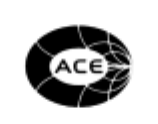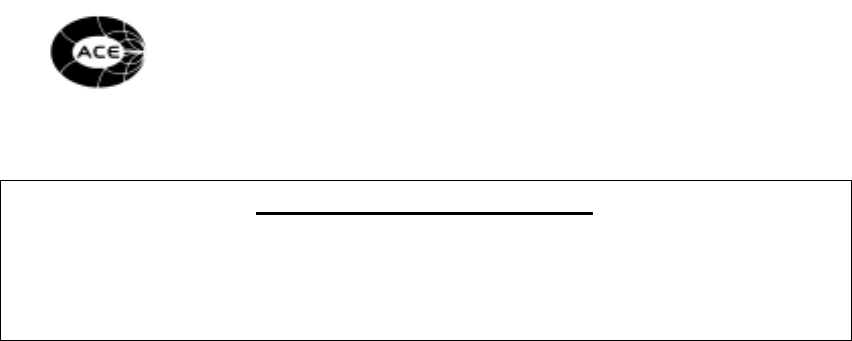Ace Antenna USR-1900 PCS Repeater User Manual
Ace Antenna Company, Inc PCS Repeater
User Manual

ACE Technology
USR-1900
Installation and Operations Manual
04/2001
ACE TECHNOLOGY
ACE Technology, Inc.
21010 Superior Street
Chatsworth, California
Tel: (818) 718 1534
Fax: (818) 718 2842
Email: aceusa@aceteq.com
Web: www.aceteq.com

ACE Technology
2
Table of Contents
1. General Information
1.1 Introduction
1.2 Specifications
1.3 Description
2 Installation
2.1 Introduction
2.2 Unpacking and Inspection
2.3 Preparation for Use
2.4 Before Installation
2.5 Antenna Installation
2.6 Repeater Installation
2.7 Connectors
2.8 Installation Example
3 Operation
3.1 Introduction
3.2 Operating Instructions
4 Trouble Shooting
5 Drawings

ACE Technology
3
1. General Information
1.1 Introduction
This manual provides information pertaining to the installation and operation of
ACE Technology’s USR-1900A/B “Ultra Slim” repeaters. Both units are for
CDMA modulation in the PCS frequencies as shown in Table 1-1.
<Table 1-1: USR-1900 Repeater Models>
Model Number Down Link*
Frequencies Up Link**
Frequencies Modulation
USR-1900A 1930 ~ 1945 MHz 1850 ~ 1865 MHz CDMA
USR-1900B 1950 ~ 1965 MHz 1870 ~1885 MHz CDMA
*: Down Link is from base station to mobile
**: Up Link is from mobile to base station

ACE Technology
4
1.2 Specifications
<Table 1-2: USR-1900 Specifications>
Down Link 1930 ~ 1945 MHz (PCS A Band), 1950~1965 MHz (B Band)
Frequency
Band Up Link 1850 ~ 1865 MHz (PCS A Band), 1870~1885 MHz (B Band)
Bandwidth 15 MHz
Maximum Output Power + 25 mW (+ 14 dBm) CDMA (3FA Composite)
Noise Figure Less Than 8 dB
Gain Range 55 dB to 85 dB
POWER O/P 1dB C.P. 21 dBm
Attenuation Control Range 30 dB
Attenuation Control Steps 2 dB
Gain Variation by Temperature
( - 10 ºC ~ + 45 ºC) ± 2 dB
V.S.W.R 2 : 1 Max.
Signal Delay Less than 5 µsec
Spurious 45 dBc @ fo ± 885 kHz ( RBW 30kHz)
55 dBc @ fo ± 1.98MHz ( RBW 30kHz)
Impedance 50 Ω
Alarm & Status LED Power On: Green
Down Link Overpower, Up Link Overpower
Down Link PLL, Up Link PLL
Power Supply 110 VAC, 50 ~ 60Hz, 16W
Operating –10 °C to 45 °C
Temperature Storage – 40 °C to 85 °C
Dimension ( W x H x D , inch) 8.07" x 2.44" x 6.00"
Weight (Pound) 3.5 lb.
RF Connectors Type N Female
1.3 Description
This product is designed for offices, hotel rooms, small parking lots, garages or
small buildings, helping to improve PCS communications signal and coverage by
extending the coverage of a base station.
Outdoor antenna receives from a PCS base station, then USR1900 repeater
amplifies the signal. After amplification, the signal is passed through to the indoor
antennas. Conversely, signals from handsets are amplified and retransmitted to the
base station.

ACE Technology
5
2. Installation
2.1 Introduction
This section provides information for the installation and setup of the USR-1900
repeater. The information consists of procedures for unpacking, inspection and
preparation for the installation, as well as the actual installation and the setup.
2.2 Unpacking and Inspection
Examine the shipping carton for damage before unpacking the unit. If the shipping
carton is damaged, try to have the carrier’s agent present when the equipment is
unpacked. If visual inspection reveals physical damage(s) to the equipment, you
should send it back for replacement.
Verify that the equipment is complete, as listed under packing slip. Contact ACE
Technology with any missing component.
2.3 Preparation for Use
2.3.1 Power Requirements
The power supply of the USR-1900 accepts 110 VAC, at 50 ~ 60 Hz. Power
consumption of the USR-1900 is approximately 16 Watts.
2.3.2 Operating Environment
The USR-1900 is intended for indoor use only. Do not install it where it might be
exposed to the outside elements as this could result in destruction of the unit and
other hazards.
For normal operations, the environmental conditions should be as follow:
Temperature range: –10 °C to 45 °C, Maximum Humidity: 95 %
Professional Installation Only
Although the installation of the repeater unit is simple and straightforward, the transmission
lines for both external and internal antennas require professional installation by a licensed
communication technician. In addition, the installation must conform to all applicable
federal, state and local government regulations.

ACE Technology
6
2.4 Before Installation
You will need to determine the following before beginning the USR-1900
installation:
a. Base station location
b. Location where the outdoor antenna is to be installed
c. Location where the indoor antenna is to be installed
d. Location where the USR-1900 is to be installed
e. Length and type of coaxial cable needed to connect from the outdoor antenna to
the repeater unit
f. Length and type of coaxial cable needed to connect from the repeater unit to the
indoor antenna
2.5 Antenna Installation
2.5.1 Outdoor Antenna
Select a site for your outdoor antenna, making sure you have enough signal strength
at that location. Using coax cable, connect the antenna to the repeater. If you are
using a directional antenna such as a Yagi type, the antenna should be installed so
that it is in line of sight of the base station. Then, align the directional antenna
toward that direction, and secure the antenna using provided mounting hardware.
Use of a lightning arrester is highly recommended. By installing a lightning
arrester between the outside antenna and the repeater, you can protect the repeater
unit from electrical surge from lightning.
CAUTION: In order to comply with FCC rules for RF exposure, the
following must be observed:
The antenna must be installed such that a minimum separation distance
of 20 cm is maintained between the antenna and any persons.

ACE Technology
7
2.5.2 Indoor Antenna
Install the indoor antenna at a convenient location. It should be free of metallic
obstruction in order to have an effective coverage. Depending on the circumstance
of the installation, either one or a combination of following antennas can be used:
Ceiling mount patch antenna, Wall mount patch antenna, Corner reflector
2.6 Repeater Installation
USR-1900 is an indoor repeater. Accordingly, the environment of the intended
installation site needs to be considered. The repeater must be shielded from
moisture, such as rain, and excessive temperatures. The operating temperatures
should be between -10 °C and 45 °C.
2.6.1 Turn-On Procedure
Verify all RF connectors are tightened and cables and antennas are secured. On the
repeater, switch “ON/OFF” to ON position. The Power indicator LED should be
green. Make sure that no other LED is illuminated. If any other LED is lit, consult
the trouble shooting page of this manual, or “2.6.2 Antenna Isolation and
Alignment” section.
2.6.2 Antenna Isolation and Alignment
USR-1900 is equipped with an over drive protection circuit. If the circuit detects
that the repeater is transmitting at a power level above that allowed by the FCC, it
shuts down the repeater and the appropriate overdrive LED will start to blink. In
the event that this condition persists for more than 3 minutes, the repeater will shut
itself down and needs to be reset, by turning the AC power switch off and on, to
resume operation.

ACE Technology
8
A. Antenna Isolation
If the isolation between the outdoor and indoor antennas is not sufficient, the repeater
will oscillate and turn itself off. It is recommended that when turning on the repeater
for the first time, both the up link and down link attenuation, marked “UPLINK
ATT.” and “DOWNLINK ATT.” respectively, should be fully engaged. The
dipswitch setting and the levels of attenuation are shown in figure 2-6 and Table 2-6.
<Figure 2-6: Dipswitch setting>
<Table 2-6: Dipswitch Setting>
Dipswitch Number 1234
Attenuation (dB), (Dipswitch ON) 2 4 8 16
As shown in table 2-6, each dipswitch has different attenuation associated with it,
and may be used in combination of others. For example, to obtain an attenuation of
20 dB, dipswitches number 2 and 4 should be in “ON” position, and the dipswitches
number 1 and 3 should be in “OFF” position. (0 + 4 + 0 + 16 = 20). Attenuation
level can be set from 0 to 30 dB by 2 db increments.
Starting from the maximum attenuation, 30 dB, decrease the attenuation level in
2 dB steps by manipulating the dipswitches until all the switches are in “OFF”
position, or stop and back off by 2 dB if you trigger either of the over-drive alarms,
“OVRPWR ALM”, for maximum gain.
B. Antenna Alignment
If you are triggering the overdrive alarms at any point, try to increase the isolation
between the antennas by relocating them. The indoor antenna should be placed
physically as far away from the outdoor antenna as practical. If the geometry of the
intended coverage area allows it, you should also try the indoor antenna in such
way that interference between the antennas is at the minimum. If you are using
directional antennas, try to find a location for the indoor antenna where it can cover
the needed area and oriented back to back with respect to the outdoor antenna.
N
O
1 2 3 4 OFF
ON

ACE Technology
9
2.7 Connectors
Figure 2-7 shows the connectors and Table 2-7 provides a description of each
connector on the USR-1900 unit
<Table 2-7: USR-1900 Connectors>
Label Description
AC IN Multipin AC Power connector with grounded plug
supplying AC to the power supply in this unit
TO BASE N-type female connector transmits base station RF,
receives mobile RF, and connects to the outdoor antenna
TO MOBILE N-type female connector transmits mobile RF, receives
base station RF, and connects to the indoor antenna
<Figure 2-7: USR-1900 Connectors>

ACE Technology
10
2.8 Installation Example
USR-1900 can be installed with multiple indoor antennas as shown in Figure 2-8.
In this example, a 6-way power splitter was used to split the signal to and from the
indoor antennas.
<Figure 2-8: USR-1900 Installation Example>

ACE Technology
11
3. Operation
3.1 Introduction
This section provides information for operating the USR-1900 repeater.
3.2 Operating Instruction
3.2.1 Power-up
Connect the repeater to AC power supply using the provided power cable. Push the
“SWITCH” to “ON” position. The red LED on the switch should light up. All five
LEDs will blink momentarily while the unit goes through initialization, which
includes checking the alarm status. If no alarm condition is present, only the
“POWER” LED will remain lit. The repeater is then operating properly.
3.2.2 Alarm Status
3.2.2.1 Overdrive Alarm
There are two overdrive alarms on the unit, one for the down link marked
“DWNLNK OVRP ALM”, and another for the up link marked “UPLNK OVRP
ALM”. Over driving occurs when the RF output power of the repeater exceeds a
prescribed limit. This means that the input RF power level is too high, or the
repeater is oscillating. The condition may be transient, caused by a passing
emergency vehicle emitting a strong signal for example, or permanent, due to a
nearby base station. It may also indicate low isolation between the antennas, which
causes the unit to oscillate (please refer to the section 2.6.2 of this manual for
antenna alignment and isolation.)
The overdrive alarms on the USR-1900 repeater are design to detect whether the over
driving is transient or permanent. When overdriving is detected, power to the RF
power is cut off and the LED flashes. After approximately 1 minute, the unit will test
to see if the condition persists. If it does not detect overdrive the unit will power up and
continue to operate. If it still detects overdrive, it will wait another minute. If it detects
overdrive for the third time, it will shutdown the unit completely. Once the shutdown
is triggered the system needs to be re-initialized by turning the AC power off and on in
order for the repeater to function.

ACE Technology
12
3.2.2.2 PLL Unlock Alarm
There are two PLL unlock alarms on the unit, one for the down link marked “DWN
PLLALM” and another for the up link marked “UP PLLALM”. These alarms are
triggered when the PLLs, critical components of the repeater, fail to function
properly. The unit will not operate while either one of the alarms is on. Turn off
the power and call for service. This malfunction is both critical and permanent.
The unit needs to be replaced.
3.2.2.3 Power Alarm
The AC power indicator, marked “POWER” doubles as the power alarm. It
monitors the function of the power supply. If the power supply malfunctions, or the
AC input voltage is out of range (85 – 132 VAC), it will cut off the power to the RF
part of the repeater. However, power to the controller is still available to keep the
alarm on, which is indicated by flashing POWER LED. If the AC power supply is
determined to be within the range and the power alarm is still on, then power down
the unit and call for service.
4. Trouble Shooting
If the repeater does not operate properly after installation, first make sure that the
installation procedures as described in section 2 of this manual were followed
correctly. Inspect each connection, both RF and AC, and connectors for a secure
fit, checking to see if all the connections are made to the proper ports of the unit and
the antennas.
If the malfunction is due to an alarm condition, refer to the appropriate part of the
section 3.2 of this manual. Corrective actions may be taken for the overdrive
alarms. However, if the PLL unlock alarms or the Power alarm is (are) on, the unit
needs to be repaired by a factory-authorized technician.
There are no user serviceable parts in the USR-1900.
DO NOT OPEN the unit. There is a danger of an electric
shock. Opening the covers of the unit will void all warranties.
CAUTION!

ACE Technology
13
5. Drawings
5.1 Front and Back views
<Figure 5-1: USR-1900 Front and Back views>
5.2 Top and Bottom views
<Figure 5-2: USR-1900 Top and Bottom views>

ACE Technology
14
5.3 Side views
<Figure 5-3: USR-1900 Side views>